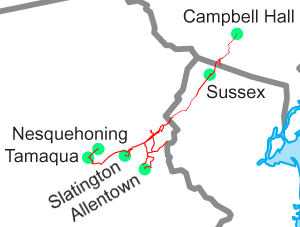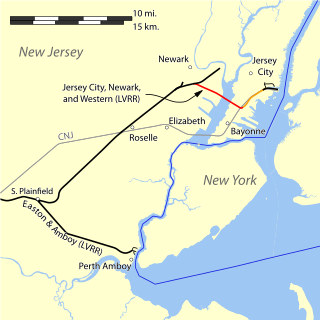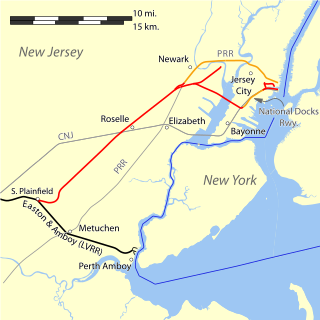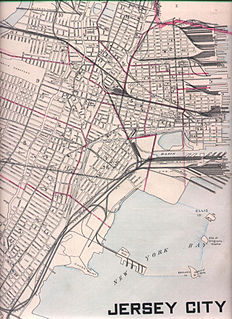The Lehigh Valley Railroad was a railroad built in the Northeastern United States to haul anthracite coal from the Pennsylvania Coal Region. The railroad was authorized on April 21, 1846 for freight and transportation of passengers, goods, wares, merchandise and minerals in the U.S. state of Pennsylvania and the railroad was incorporated and established on September 20, 1847 as the Delaware, Lehigh, Schuylkill and Susquehanna Railroad Company. On January 7, 1853, the railroad's name was changed to Lehigh Valley Railroad. It was sometimes known as the Route of the Black Diamond, named after the anthracite it transported. At the time, anthracite was transported by boat down the Lehigh River. The railroad ended operations in 1976 and merged into Conrail along with several northeastern railroads that same year.

The Central Railroad of New Jersey, also known as the Jersey Central or Jersey Central Lines, was a Class I railroad with origins in the 1830s. It was absorbed into Conrail in April 1976 along with several other prominent bankrupt railroads of the Northeastern United States.

For the purposes of this article, the Jersey City area extends North to Edgewater, South to Bayonne and includes Kearny Junction and Harrison but not Newark. Many routes east of Newark are listed here.

The Raritan Valley Line is a commuter rail service operated by New Jersey Transit (NJT) which serves passengers in municipalities in Union, Somerset, and Hunterdon counties in the Raritan Valley region in central New Jersey, United States. The line's most frequent western terminus is Raritan station in Raritan. Some weekday trains continue farther west and terminate at the High Bridge station, located in High Bridge. Most eastbound trains terminate in Newark; passengers bound for New York make a cross-platform transfer. A limited number of weekday trains continue directly to New York.

The Aldene Connection is a connection between two railroad lines in the Aldene neighborhood of Roselle Park, New Jersey, United States, one formerly belonging to the Central Railroad of New Jersey (CNJ), the other formerly of the Lehigh Valley Railroad. The connections allow trains on the New Jersey Transit Raritan Valley Line to travel from Cranford through stations in Roselle Park and Union to the Hunter Connection in Newark, which in turn allows access to the Northeast Corridor and Newark Penn Station.

The Lehigh and Hudson River Railway (L&HR) was the smallest of the six railroads that were merged into Conrail in 1976. It was a bridge line running northeast–southwest across northwestern New Jersey, connecting the line to the Poughkeepsie Bridge at Maybrook, New York with Easton, Pennsylvania, where it interchanged with various other companies.

The Lehigh & New England Railroad was a Class I railroad located in Northeastern United States that acted as a bridge line. It was the second notable U.S. railroad to file for abandonment in its entirety, the first being the New York, Ontario & Western Railway.

The Conrail Lehigh Line is a railroad line in New Jersey that is part of Conrail Shared Assets Operations under the North Jersey Shared Assets Area division. The line runs from CP Port Reading Junction in Manville to Oak Island Yard in Newark. The line is double-track and signaled through its entire length. The line began operations in 1999 using former existing tracks from Manville to Newark that was once part of the original Lehigh Line which is still in existence and is owned and operated by Norfolk Southern Railway.

Roselle Park is a New Jersey Transit railroad station in Roselle Park, New Jersey. Located on the Conrail Lehigh Line which is owned by Conrail Shared Assets Operations on West Lincoln Avenue between Chestnut Street and Locust Street, it is served by Raritan Valley Line trains that travel between Newark Penn Station and Raritan. There is also limited service between High Bridge and New York Penn Station and one weekday morning train to Hoboken Terminal.

Union is a NJ Transit railroad station in Union, New Jersey. Located on the Conrail Lehigh Line, Union is served by Raritan Valley Line trains that travel between Newark Penn Station and Raritan. There is also limited service to and from High Bridge and New York Penn Station and one morning train to Hoboken Terminal. The physical structures of the station are owned by New Jersey Transit, however the land remains property of Norfolk Southern Railway, in accordance with the 1999 buyout of Consolidated Rail Corporation by Norfolk Southern Railway and CSX Corporation.

Easton and Amboy Railroad was a railroad built across central New Jersey by the Lehigh Valley Railroad (LVRR) in the 1870s. The line was built to connect the Lehigh Valley Railroad coal hauling operations in Pennsylvania with the Port of New York and New Jersey to serve consumer markets in New York metropolitan area. Until it was built, the terminus of the LVRR had been at Phillipsburg, New Jersey on the Delaware River opposite Easton, Pennsylvania. It is now part of Norfolk Southern Railway operations, partially the Lehigh Line

The Newark and Roselle Railway was incorporated on Aug 28, 1889 by the Lehigh Valley Railroad (LVRR) to advance tracks from the terminus of the Roselle and South Plainfield Railway at Roselle, New Jersey to Pennsylvania Avenue in Newark. It formed part of the route connecting the LVRR's Easton and Amboy Railroad at South Plainfield to the Jersey City terminal.

The Newark and Passaic Railway was incorporated on Nov 22, 1889 by the Lehigh Valley Railroad (LVRR). It was chartered as a short line in Newark, New Jersey from the Passaic River to a connection with the LVRR's Newark and Roselle Railway near Pennsylvania Avenue in Newark. The lower mile of its length closed a gap in the route of the LVRR from South Plainfield to Jersey City.

The Jersey City, Newark and Western Railway was incorporated on July 6, 1889, and acquired by the Lehigh Valley Railroad (LVRR). Construction was completed in 1893. It started in Jersey City, New Jersey at a connection with the National Docks Railway in Communipaw east of the Central Railroad of New Jersey line, and extended westward on the bridge across Newark Bay to connect with the LVRR's Newark and Passaic Railway.

The Roselle and South Plainfield Railway was a railroad built by the Lehigh Valley Railroad (LVRR) in 1888 to connect the LVRR's Easton and Amboy Railroad with the Central Railroad of New Jersey (CNJ), and provided access over the CNJ to the Hudson River waterfront in Jersey City. The LVRR had built coal docks in Perth Amboy when it built the Easton and Amboy in the 1870s, but it desired a terminal on the Hudson River close to New York City.

The Lehigh Valley Terminal Railway was a Lehigh Valley Railroad company organized in 1891 through the consolidation of the companies that formed the Lehigh Valley's route from South Plainfield through Newark to Jersey City via its bridge across Newark Bay. Until 1895, when the Greenville and Hudson Railway was constructed, the Lehigh Valley depended on the National Docks Railway to reach the Hudson River terminal.

The Upper Bay Bridge, or the Lehigh Valley Railroad Bridge, is a vertical lift bridge spanning the Newark Bay in northeastern New Jersey. It is used by CSX Transportation travelling through the North Jersey Shared Assets Area of the United States rail network along the National Docks Secondary line. The bridge is just north and parallel to the New Jersey Turnpike's Newark Bay Bridge. A notable train using the bridge is the Juice Train, which originates in Florida.

National Docks Secondary is a freight rail line within Conrail's North Jersey Shared Assets Area in Hudson County, New Jersey, used by CSX Transportation. It provides access for the national rail network to maritime, industrial, and distribution facilities at Port Jersey, the Military Ocean Terminal at Bayonne (MOTBY), and Constable Hook as well as carfloat operations at Greenville Yard. The line is an important component in the planned expansion of facilities in the Port of New York and New Jersey. The single track right of way comprises rail beds, viaducts, bridges, and tunnels originally developed at the end of the 19th century by competing railroads.

The Lehigh Line is a railroad line in central New Jersey and northeastern Pennsylvania, in the United States. It is owned and operated by the Norfolk Southern Railway. The line runs west from the vicinity of the Port of New York and New Jersey to the Susquehanna River valley at the south end of the Wyoming Valley Coal Region. Administratively it is part of Norfolk Southern's Keystone Division (Harrisburg) and is also part of the Crescent Corridor. As of 2021 the line is freight-only, although there are perennial proposals to restore passenger service over all or part of the line.



















